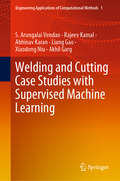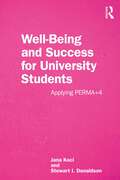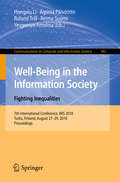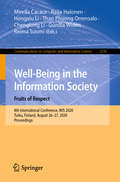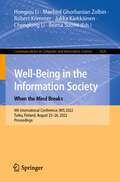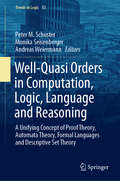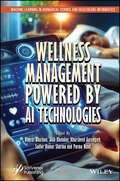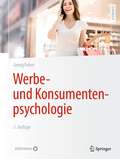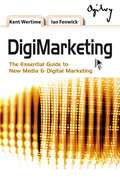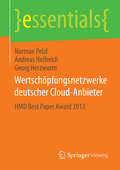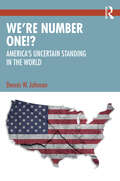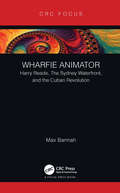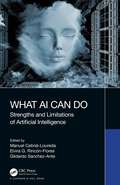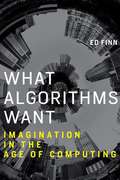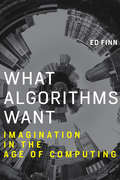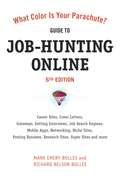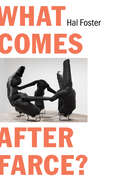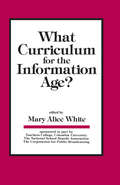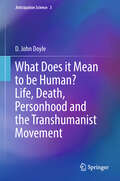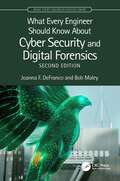- Table View
- List View
Welding and Cutting Case Studies with Supervised Machine Learning (Engineering Applications of Computational Methods #1)
by S. Arungalai Vendan Liang Gao Akhil Garg Rajeev Kamal Abhinav Karan Xiaodong NiuThis book presents machine learning as a set of pre-requisites, co-requisites, and post-requisites, focusing on mathematical concepts and engineering applications in advanced welding and cutting processes. It describes a number of advanced welding and cutting processes and then assesses the parametrical interdependencies of two entities, namely the data analysis and data visualization techniques, which form the core of machine learning. Subsequently, it discusses supervised learning, highlighting Python libraries such as NumPy, Pandas and Scikit Learn programming. It also includes case studies that employ machine learning for manufacturing processes in the engineering domain. The book not only provides beginners with an introduction to machine learning for applied sciences, enabling them to address global competitiveness and work on real-time technical challenges, it is also a valuable resource for scholars with domain knowledge.
Well Packed – Not a Bit Too Much: Compression of Digital Data Explained in an Understandable Way (essentials)
by Olaf ManzWith today's flood of data circulating on storage media and the Internet, compression of digital data remains an immensely important aspect of data transmission and storage. This essential explains, without theoretical superstructure and with elementary mathematical methods, the most important compression methods, such as the entropy encodings of Shannon-Fano and of Huffman, as well as the dictionary encodings of the Lempel-Ziv family. Irrelevance reduction and quantization for optical and acoustic signals, which exploit the inadequacies of the human eye and ear for data compression, are also discussed in detail. The whole is illustrated by means of common practical applications from the everyday environment. The presentation allows the use, for example, in working groups at schools, in introductory courses at universities and is also suitable for interested laypersons.This Springer essential is a translation of the original German 1st edition essentials, Gut gepackt – Kein Bit zu viel by Olaf Manz, published by Springer Fachmedien Wiesbaden GmbH, part of Springer Nature in 2020. The translation was done with the help of artificial intelligence (machine translation by the service DeepL.com). A subsequent human revision was done primarily in terms of content, so that the book will read stylistically differently from a conventional translation. Springer Nature works continuously to further the development of tools for the production of books and on the related technologies to support the authors.
Well-Being and Success For University Students: Applying PERMA+4
by Stewart I. Donaldson Jana KociWell-Being and Success for University Students: Applying PERMA+4 is grounded in the science of well-being and positive psychology and teaches students how to strengthen their health and well-being, as well as to make their study journey more enjoyable and successful. Higher education has changed dramatically during the last few years, and given the massive growth of mental health challenges among students, universities and faculty have recognized the need to help students to strive, not only survive. Universities have a great potential and responsibility to promote the well-being of their students. This book provides students with information, motivation, and skills to build their own unique well-being and helps colleges to produce more well-being in the university culture. Students and faculty will be introduced to PERMA+4, an evidence-based framework for enhancing well-being and positive functioning, including academic performance. This book emphasizes practical applications of findings from the best available research to have students learn several steps they can take to strengthen their well-being and academic performance. Individual chapters talk about popular topics of positive psychology such as positive emotions, engagement, relationships, meaning, achievement, physical health, mindset, environment, and economic security. Each chapter summarizes the knowledge on specific topics, invites students to assess their well-being in the particular life domain, and encourages them to explore and try activities and evidence-based interventions to learn how to care for their own mental and overall health. This book not only serves as a guide for students but also as a useful tool for professors seeking to enhance their courses and programs with well-being promotion and student wellness centers across the world.
Well-Being in the Information Society. Fighting Inequalities: 7th International Conference, WIS 2018, Turku, Finland, August 27-29, 2018, Proceedings (Communications in Computer and Information Science #907)
by Reima Suomi Hongxiu Li Ágústa Pálsdóttir Roland Trill Yevgeniya AmelinaThis book constitutes the refereed proceedings of the 7th International Conference on Well-Being in the Information Society, WIS 2018, held in Turku, Finland, in August 2018.The 19 revised full papers presented were carefully reviewed and selected from 42 submissions. With the core topic "Fighting Inequalities" WIS 2018 focused on innovations and fresh ideas in the cross-section of information society and health as understood in a wide sense. The papers presented in this volume are organized along the following broad topics: digital society and e-health.
Well-Being in the Information Society. Fruits of Respect: 8th International Conference, WIS 2020, Turku, Finland, August 26–27, 2020, Proceedings (Communications in Computer and Information Science #1270)
by Reima Suomi Mirella Cacace Hongxiu Li Gunilla Widén Raija Halonen Thao Phuong Orrensalo Chenglong LiThis book constitutes the refereed proceedings of the 8th International Conference on Well-Being in the Information Society, WIS 2020, held in Turku, Finland, in August 2020. Due to the COVID-19 pandemic the conference was held online. The 19 revised full papers presented were carefully reviewed and selected from 25 submissions. The submitted papers present academic contributions on the topics of intersection of health, ICT and fruits of respect as seen from different directions and contexts. The paperd are organized in the following topical sections: improving quality and containing cost in health care and care for the elderly by using information technology; collecting the fruits of respect in entrepreneurship and management of organizations; friend or foe: society in the area of tension between free data movement and data protection; bridging the digital divide: strengthening (health-) literacy and supporting trainings in information society.
Well-Being in the Information Society: 9th International Conference, WIS 2022, Turku, Finland, August 25–26, 2022, Proceedings (Communications in Computer and Information Science #1626)
by Reima Suomi Hongxiu Li Robert Krimmer Chenglong Li Maehed Ghorbanian Zolbin Jukka KärkkäinenThis book constitutes the refereed proceedings of the 9th International Conference on Well-Being in the Information Society, WIS 2022, held in Turku, Finland, in August 2022. The 14 revised full papers presented were carefully reviewed and selected from 17 submissions. The proceedings are structured in four sections as follows: mental well-being and e-health; social media and well-being; innovative solution for well-being in the information society; driving well-being in the information society.
Well-Quasi Orders in Computation, Logic, Language and Reasoning: A Unifying Concept of Proof Theory, Automata Theory, Formal Languages and Descriptive Set Theory (Trends in Logic #53)
by Peter M. Schuster Monika Seisenberger Andreas WeiermannThis book bridges the gaps between logic, mathematics and computer science by delving into the theory of well-quasi orders, also known as wqos. This highly active branch of combinatorics is deeply rooted in and between many fields of mathematics and logic, including proof theory, commutative algebra, braid groups, graph theory, analytic combinatorics, theory of relations, reverse mathematics and subrecursive hierarchies. As a unifying concept for slick finiteness or termination proofs, wqos have been rediscovered in diverse contexts, and proven to be extremely useful in computer science. The book introduces readers to the many facets of, and recent developments in, wqos through chapters contributed by scholars from various fields. As such, it offers a valuable asset for logicians, mathematicians and computer scientists, as well as scholars and students.
Wellness Management Powered by AI Technologies (Machine Learning in Biomedical Science and Healthcare Informatics)
by Bharat Bhushan Sudhir Kumar Sharma Parma Nand Khursheed Aurangzeb Akib KhandayThis book is an essential resource on the impact of AI in medical systems, helping readers stay ahead in the modern era with cutting-edge solutions, knowledge, and real-world case studies. Wellness Management Powered by AI Technologies explores the intricate ways machine learning and the Internet of Things (IoT) have been woven into the fabric of healthcare solutions. From smart wearable devices tracking vital signs in real time to ML-driven diagnostic tools providing accurate predictions, readers will gain insights into how these technologies continually reshape healthcare. The book begins by examining the fundamental principles of machine learning and IoT, providing readers with a solid understanding of the underlying concepts. Through clear and concise explanations, readers will grasp the complexities of the algorithms that power predictive analytics, disease detection, and personalized treatment recommendations. In parallel, they will uncover the role of IoT devices in collecting data that fuels these intelligent systems, bridging the gap between patients and practitioners. In the following chapters, readers will delve into real-world case studies and success stories that illustrate the tangible benefits of this dynamic duo. This book is not merely a technical exposition; it serves as a roadmap for healthcare professionals and anyone invested in the future of healthcare. Readers will find the book: Explores how AI is transforming diagnostics, treatments, and healthcare delivery, offering cutting-edge solutions for modern healthcare challenges; Provides practical knowledge on implementing AI in healthcare settings, enhancing efficiency and patient outcomes; Offers authoritative insights into current AI trends and future developments in healthcare; Features real-world case studies and examples showcasing successful AI integrations in various medical fields. Audience This book is a valuable resource for researchers, industry professionals, and engineers from diverse fields such as computer science, artificial intelligence, electronics and electrical engineering, healthcare management, and policymakers.
Wer sehen will, muss spüren: Warum uns manche Serien und Filme berühren und uns andere kaltlassen (Über/Strom: Wegweiser durchs digitale Zeitalter)
by Wiebke SchwelgengräberWarum berühren uns Serien wie „Game of Thrones“, „Breaking Bad“, „Sex Education“ und Filme wie „Es“, „Sieben“, oder „Mamma Mia!“? Manchmal sind wir gefesselt von einem Film oder einer Serie und vergessen alles um uns herum. Und ein anderes Mal vergeht die Zeit einfach nicht und der Film langweilt uns zu Tode. Wieder andere Filme und Serien können wir gar nicht erst aushalten, weil Gewalt, Ekel, und Demütigungen von Figuren uns unangenehm vereinnahmen und geradezu einschnüren.In diesem Buch erfahren Sie, wie Filme und Serien uns emotional berühren - oder eben auch nicht. Anhand zahlreicher Beispiele lernen Sie, wie Langeweile, Freude, Angst, Empathie, Ekel, Nervosität, Scham, Schrecken oder Sehnsucht beim Film- und Serienschauen geradezu leiblich spürbar werden. Diese philosophischen Betrachtungen werden jeweils psychologisch eingeordnet, um einen umfassenden Blick auf das ‚Spüren beim Sehen‘ zu erlangen. .Der InhaltGeschichten verbinden unsGeschichten berühren unsKatharsis nach AristotelesLeibphänomenologieDas Phänomen Binge-WatchingGeschichten wollen erinnert werdenEntladung von Wut und EnttäuschungEntladung von SehnsuchtGeschichten lassen uns trotzdem manchmal kaltGeschichten verändern unsDie ZielgruppePersonen, die Filme und Serien schauen, Rezensionen/Kritiken lesen, im Alltag über ebenjene mit anderen sprechen
Werbe- und Konsumentenpsychologie
by Georg FelserWie funktioniert Werbung? Wie werden Kaufentscheidungen beeinflusst? Wie manipulierbar sind wir als Konsumentinnen und Konsumenten? Welche Methoden im Marketing funktionieren und warum? Das Buch „Werbe- und Konsumentenpsychologie“ gibt Antworten auf diese Fragen. Mit der fünften Auflage des seit Jahren erfolgreichen und prüfungsrelevanten Lehrbuchklassikers halten Sie die psychologischen Grundlagen des Neuromarketings und der Verhaltensökonomie in Ihren Händen. Wussten Sie, dass ein nicht geringer Teil unseres Konsumverhaltens durch automatische, unbewusste und »implizite« Prozesse gesteuert wird? In diesem leicht verständlichen und gleichzeitig wissenschaftlich anspruchsvollen Buch erfahren Sie, welche Rolle diesen Prozessen tatsächlich zukommt. Diese Neuauflage wurde um eine Vielzahl aktueller Forschungsergebnisse sowie neuer Textabschnitte und Kapitel wie z.B. zum digitalen Marketing, Werbung über Influencer, die Bedeutung von Kundenrezensionen, die Folgen des E-Commerce, Online- und Versandhandel und „innovative“ Werbeformen wie z.B. Ambient Marketing oder Native Advertising erweitert.
Werkzeuge der digitalen Wirtschaft: Eine Einführung in relationale und nicht-relationale Datenbanken (essentials)
by Andreas MeierDas essential f#65533;hrt in Big Data ein und erl#65533;utert die wichtigsten Werkzeuge zur Nutzung von SQL- wie NoSQL-Technologien. Neben semantischer Datenmodellierung, Abfragesprachen, Konsistenzgew#65533;hrung mit ACID oder BASE werden NoSQL-Datenbanken vorgestellt und organisatorische Aspekte des Datenmanagements erl#65533;utert. Der Leser erh#65533;lt mit diesem Kompendium die wichtigsten Grundlagen sowohl zu SQL- wie auch zu NoSQL-Datenbanken.
Wertime
by Kent Wertime Ian Fenwick"We are all DigiMarketers now - or we should be. The authors have for the first time provided a lucid, hype-free, business-based and practical guide to the new age of marketing: it is a kind of digital Baedeker, which should be on every businessman's book-shelf. " -Miles Young, Chairman, Ogilvy & Mather Asia Pacific "The digital frontier is now the center of our universe. As Kent Wertime and Ian Fenwick show, marketers must seize this digital opportunity to accelerate their market growth. " -John A. Quelch, Senior Associate Dean and Lincoln Filene Professor of Business Administration, Harvard Business School "Too many advertisers are stuck in the primordial soup when it comes to their digital marketing strategy. However, they need to evolve fast if they are to survive in a multi-channel landscape. This timely book acts like an Origin of the Species, steering hesitant brand owners through the complexities of the digital ecosystem. An impressive blend of academic theory, professional insight and practical advice. " -Paul Kemp-Robertson, Co-founder & Editorial Director, Contagious www. contagiousmagazine. com "DigiMarketing: The Essential Guide to New Marketing & Digital Media is a clear call for companies to evolve their marketing practice. This book is essential reading for anyone seeking a roadmap to the future of business. " -Dipak C. Jain, Dean, Kellogg School of Management "The rise of conversational media new forms of distribution - from blogs to mobile platforms - challenge traditional approaches to marketing, and require every business to have a transition plan. Kent Wertime and Ian Fenwick have written a book that is required reading for any marketers interested in successfully making that transition. " -John Battelle, CEO and Founder, Federated Media Publishing and Author, The Search "Kent Wertime and Ian Fenwick have written the definitive guide to marketing in the digital age. But Digimarketing does more than educate marketing professionals. It describes the new media landscape brilliantly, making it an essential read for anyone who hopes to understand the most important technological revolution of the past fifty years. I wore out three yellow highlighters before realizing that every sentence and every paragraph is worth committing to memory. " -Norman Pearlstine, Former Editor-in-Chief, Time Inc. and Managing Editor, The Wall Street Journal, Senior Advisor, Telecommunications & Media, The Carlyle Group
Wertschöpfung und Digitalisierung: Konzepte und Methoden zur Umsetzung in Projekten
by Jürgen SchröderDas Buch beschreibt Methoden und Konzepte, die in verschiedenen Forschungs- und Praxisprojekten eingesetzt wurden. Diese Forschung basiert auf dem Lean Management und der Wertschöpfungsorientierung in Projekten und Produktionsprozessen. Die Methoden ermöglichen eine zielgerichtete Optimierung von Prozessen hinsichtlich deren Wertschöpfung. Darunter fallen die Value Added Heat Map sowie die Value Stream Model and Notation als Visualisierungsmethoden. Ein weiterer Schwerpunkt ist der Zusammenhang von Maßnahmen zur Digitalisierung bzw. der digitalen Transformation und deren Auswirkung auf die Wertschöpfungskonzentration in Unternehmen und Dienstleistungsbetrieben. Außerdem wird dargestellt, inwiefern die Zusammenarbeit von Hochschulen und Unternehmen einen Beitrag zur Wertschöpfungssteigerung leisten kann.
Wertschöpfungsnetzwerke deutscher Cloud-Anbieter: HMD Best Paper Award 2013 (essentials)
by Norman Pelzl Andreas Helferich Georg HerzwurmDie Autoren untersuchen in diesem Beitrag die Wertschöpfungsnetzwerke deutscher Cloud-Anbieter anhand einer Clusteranalyse. Auf Basis der Ergebnisse und vorgestellten Fallbeispiele sind Cloud-Anbieter in der Lage, sich einem der Cluster zuzuordnen, ihr eigenes Wertschöpfungsnetzwerk zu analysieren sowie Optionen zur Neukonfiguration der Wertschöpfungsarchitektur zu identifizieren. Cloud Computing hat nicht nur das Potenzial, IT-Nutzung signifikant umzugestalten, sondern auch IT-Angebote erheblich zu innovieren. Aufgrund des starken Marktwachstums werden etablierte IT-Anbieter gezwungen, ihre Geschäftsmodelle grundlegend zu überdenken. Die Abkehr von herkömmlichen Geschäftsmodellen erzwingt eine Neupositionierung von Aktivitäten innerhalb des Wertschöpfungsnetzwerks. Insbesondere durch die Vernetzung der Cloud-Services eröffnen sich neue Optionen für IT-Unternehmen.
We’re Number One!?: America’s Uncertain Standing in the World
by Dennis W. JohnsonWe’re Number One!?: America’s Uncertain Standing in the World compares the domestic policies of the United States to other countries across a wide variety of social, political, and economic metrics.This book demonstrates conclusively that despite America’s wealth, its strong economy, its military might, and its soft power dominance, we have far to go in comparison with other democratic, industrialized nations. We may think we’re Number One, but in too many key areas—health care, education, combating poverty, protecting the family, and so forth—we fall embarrassingly short. The shock to most readers won’t be on one or more specific policy shortcomings, but on the cumulative rankings, chapter after chapter, showing where the United States has come up short. This book presents the facts and leaves to policymakers the challenge: how do we fix our broken health care system, how do we mitigate climate disasters, or how do we rein in gun violence. One answer is to look at the successful policies created in other countries.A refreshingly frank and thorough analysis of the United States’ relative position in the world, this book will appeal to students, scholars, and practitioners of comparative politics, comparative sociology, public policy, social justice, and American government.
Wharfie Animator: Harry Reade, The Sydney Waterfront, and the Cuban Revolution
by Max BannahThis book examines the life of the Australian artist Harry Reade (1927–1998) and his largely overlooked contribution to animation. It constitutes a biography of Reade, tracing his life from his birth to his period of involvement with animation between 1956 and 1969. It explores the forces that shaped Reade and chronicles his experiences as a child, his early working life, the influence of left-wing ideology on his creative development, his introduction to animation through the small but radical Waterside Workers’ Federation Film Unit (WWFFU), and the influence he had on the development of Cuban animation as an educational tool of the Revolution. Key Features The text offers an alternative framework for considering the political, social, and cultural themes that characterised 1950s Australia and 1960s Cuba. A rare look into the cultural heritage of labor organizations and the populist power of animation to stimulate radical social consciousness. The book also crosses a range of intellectual disciplines, including Animation Studies, Art History, Cinema Studies, and the Social and Political Histories of Australia and Cuba. Max Bannah lives on Queensland’s Sunshine Coast. Between 1976 and 2010, he worked in Brisbane as an animator producing television commercials, short films, and cartoon graphics. He also lectured in Animation History and Practice and Drawing for Animation at the Queensland University of Technology where, in 2007, he completed his Masters by Research thesis, "A Cause for Animation: Harry Reade and the Cuban Revolution."
What AI Can Do: Strengths and Limitations of Artificial Intelligence
by Manuel Cebral-LouredaThe philosopher Spinoza once asserted that no one knows what a body can do, conceiving an intrinsic bodily power with unknown limits. Similarly, we can ask ourselves about Artificial Intelligence (AI): To what extent is the development of intelligence limited by its technical and material substrate? In other words, what can AI do? The answer is analogous to Spinoza’s: Nobody knows the limit of AI. Critically considering this issue from philosophical, interdisciplinary, and engineering perspectives, respectively, this book assesses the scope and pertinence of AI technology and explores how it could bring about both a better and more unpredictable future. What AI Can Do highlights, at both the theoretical and practical levels, the cross-cutting relevance that AI is having on society, appealing to students of engineering, computer science, and philosophy, as well as all who hold a practical interest in the technology.
What Algorithms Want: Imagination in the Age of Computing
by Ed FinnWe depend on -- we believe in -- algorithms to help us get a ride, choose which book to buy, execute a mathematical proof. It's as if we think of code as a magic spell, an incantation to reveal what we need to know and even what we want. Humans have always believed that certain invocations -- the marriage vow, the shaman's curse -- do not merely describe the world but make it. Computation casts a cultural shadow that is shaped by this long tradition of magical thinking. In this book, Ed Finn considers how the algorithm -- in practical terms, "a method for solving a problem" -- has its roots not only in mathematical logic but also in cybernetics, philosophy, and magical thinking. Finn argues that the algorithm deploys concepts from the idealized space of computation in a messy reality, with unpredictable and sometimes fascinating results. Drawing on sources that range from Neal Stephenson's Snow Crash to Diderot's Encyclopédie, from Adam Smith to the Star Trek computer, Finn explores the gap between theoretical ideas and pragmatic instructions. He examines the development of intelligent assistants like Siri, the rise of algorithmic aesthetics at Netflix, Ian Bogost's satiric Facebook game Cow Clicker, and the revolutionary economics of Bitcoin. He describes Google's goal of anticipating our questions, Uber's cartoon maps and black box accounting, and what Facebook tells us about programmable value, among other things.If we want to understand the gap between abstraction and messy reality, Finn argues, we need to build a model of "algorithmic reading" and scholarship that attends to process, spearheading a new experimental humanities.
What Algorithms Want: Imagination in the Age of Computing
by Ed FinnThe gap between theoretical ideas and messy reality, as seen in Neal Stephenson, Adam Smith, and Star Trek. We depend on—we believe in—algorithms to help us get a ride, choose which book to buy, execute a mathematical proof. It's as if we think of code as a magic spell, an incantation to reveal what we need to know and even what we want. Humans have always believed that certain invocations—the marriage vow, the shaman's curse—do not merely describe the world but make it. Computation casts a cultural shadow that is shaped by this long tradition of magical thinking. In this book, Ed Finn considers how the algorithm—in practical terms, “a method for solving a problem”—has its roots not only in mathematical logic but also in cybernetics, philosophy, and magical thinking. Finn argues that the algorithm deploys concepts from the idealized space of computation in a messy reality, with unpredictable and sometimes fascinating results. Drawing on sources that range from Neal Stephenson's Snow Crash to Diderot's Encyclopédie, from Adam Smith to the Star Trek computer, Finn explores the gap between theoretical ideas and pragmatic instructions. He examines the development of intelligent assistants like Siri, the rise of algorithmic aesthetics at Netflix, Ian Bogost's satiric Facebook game Cow Clicker, and the revolutionary economics of Bitcoin. He describes Google's goal of anticipating our questions, Uber's cartoon maps and black box accounting, and what Facebook tells us about programmable value, among other things.If we want to understand the gap between abstraction and messy reality, Finn argues, we need to build a model of “algorithmic reading” and scholarship that attends to process, spearheading a new experimental humanities.
What Color Is Your Parachute? Guide to Job-Hunting Online (Sixth Edition): Blogging, Career Sites, Gateways, Getting Interviews, Job Boards, Job Search Engines, Personal Websites, Posting Resumes, Research Sites, Social Networking
by Richard Nelson Bolles Mark Emery BollesBefore you start your Internet job-hunt, there are some things that you must know, like: * Why are job sites like Monster and CareerBuilder so stunningly ineffective? * What can you do to make sure your resumes survive the elimination process? * How do you find the information that search engines like Google can't? * How can you tell the difference between a genuinely helpful job board, and a website designed only to collect resumes? * When are hobby forums more helpful than business networking sites? * When is the Internet not helpful when job-hunting? * What is the fatal flaw of all social networking sites? The Guide to Job-Hunting Online, 6th Edition, not only answers these questions and many more, but shows you how to comprehensively and effectively use the Internet for all aspects of your job-hunt. This companion to What Color Is Your Parachute?, the best-selling job-hunting book in the world, has been completely rewritten for our changing times and includes hundreds of updated website recommendations and descriptions. The Guide to Job-Hunting Online shows you how to quickly find the data that will be most helpful to you, how to identify and research the places where you will most enjoy working, how to leverage the power of social networking sites, and how to use your Internet time most effectively, avoiding the common pitfalls and setting you up for success.
What Comes After Farce?: Art and Criticism at a Time of Debacle
by Hal FosterSurveying the artistic and cultural scene in the era of Trump In a world where truth is cast in doubt and shame has gone missing, what are artists and critics on the left to do? How to demystify a political order that laughs away its own contradictions? How to mock leaders who thrive on the absurd? And why, in any event, offer more outrage to a media economy that feeds on the same? Such questions are grist to the mill of Hal Foster, who, in What Comes after Farce?, delves into recent developments in art, criticism, and fiction under the current regime of war, surveillance, extreme inequality, and media disruption. Concerned first with the cultural politics of emergency since 9/11, including the use and abuse of trauma, conspiracy, and kitsch, he moves on to consider the neoliberal makeover of aesthetic forms and art institutions during the same period. A final section surveys signal transformations in art, film, and writing. Among the phenomena explored are machine vision (images produced by machines for other machines without a human interface), operational images (images that do not represent the world so much as intervene in it), and the algorithmic scripting of information that pervades our everyday lives. If all this sounds dire, it is. In many respects we look out on a world that has moved, not only politically but also technologically, beyond our control. Yet Foster also sees possibility in the current debacle: the possibility to pressure the cracks in this order, to turn emergency into change.
What Curriculum for the Information Age
by Mary Alice WhiteFirst Published in 1987. Routledge is an imprint of Taylor & Francis, an informa company.
What Customers Crave: How to Create Relevant and Memorable Experiences at Every Touchpoint
by Nicholas WebbThink you know your customers? You better be more assured than just thinking you do, because your success depends on it! The best companies in the world first research exhaustively what their customers desire, and then they deliver it in memorable and deeply human experiences--resulting in success previously believed to be unachievable. So once again, how well do you know your customers?In a hyperconnected economy that is radically changing consumer expectations, this vital expectation for any successful business is not always easy. But in What Customers Crave, author and business strategist Nicholas Webb simplifies this critical task into being able to confidently answer two questions: What do your customers love? What do they hate?Jam-packed with tools and examples, this must-have resource helps businesses reinvent how they engage with customers (both physical and virtual). Learn how to:• Gain invaluable insights into who your customers are and what they care about• Use listening posts and Contact Point Innovation to refine customer types• Engineer experiences for each micromarket that are not only exceptional, but insanely relevant• Connect across the five most important touchpoints• Co-create with your customers• And more!It’s time to reinvent the ways you engage with your customers. Because when you learn to provide for them exactly what they want, they not only bring along their wallets but those belong to their friends as well!
What Does it Mean to be Human? Life, Death, Personhood and the Transhumanist Movement (Anticipation Science #3)
by D. John DoyleThis book is a critical examination of the philosophical and moral issues in relation to human enhancement and the various related medical developments that are now rapidly moving from the laboratory into the clinical realm. In the book, the author critically examines technologies such as genetic engineering, neural implants, pharmacologic enhancement, and cryonic suspension from transhumanist and bioconservative positions, focusing primarily on moral issues and what it means to be a human in a setting where technological interventions sometimes impact strongly on our humanity. The author also introduces the notion that death is a process rather than an event, as well as identifies philosophical and clinical limitations in the contemporary determination of brain death as a precursor to organ procurement for transplantation. The discussion on what exactly it means to be dead is later applied to explore philosophical and clinical issues germane to the cryonics movement. Written by a physician/ scientist and heavily referenced to the peer-reviewed medical and scientific literature, the book is aimed at advanced students and academics but should be readable by any intelligent reader willing to carry out some side-reading. No prior knowledge of moral philosophy is assumed, as the various key approaches to moral philosophy are outlined early in the book.
What Every Engineer Should Know About Cyber Security and Digital Forensics (What Every Engineer Should Know)
by Joanna F. DeFranco Bob MaleyMost organizations place a high priority on keeping data secure, but not every organization invests in training its engineers or employees in understanding the security risks involved when using or developing technology. Designed for the non-security professional, What Every Engineer Should Know About Cyber Security and Digital Forensics is an overview of the field of cyber security. The Second Edition updates content to address the most recent cyber security concerns and introduces new topics such as business changes and outsourcing. It includes new cyber security risks such as Internet of Things and Distributed Networks (i.e., blockchain) and adds new sections on strategy based on the OODA (observe-orient-decide-act) loop in the cycle. It also includes an entire chapter on tools used by the professionals in the field. Exploring the cyber security topics that every engineer should understand, the book discusses network and personal data security, cloud and mobile computing, preparing for an incident and incident response, evidence handling, internet usage, law and compliance, and security forensic certifications. Application of the concepts is demonstrated through short case studies of real-world incidents chronologically delineating related events. The book also discusses certifications and reference manuals in the areas of cyber security and digital forensics. By mastering the principles in this volume, engineering professionals will not only better understand how to mitigate the risk of security incidents and keep their data secure, but also understand how to break into this expanding profession.
